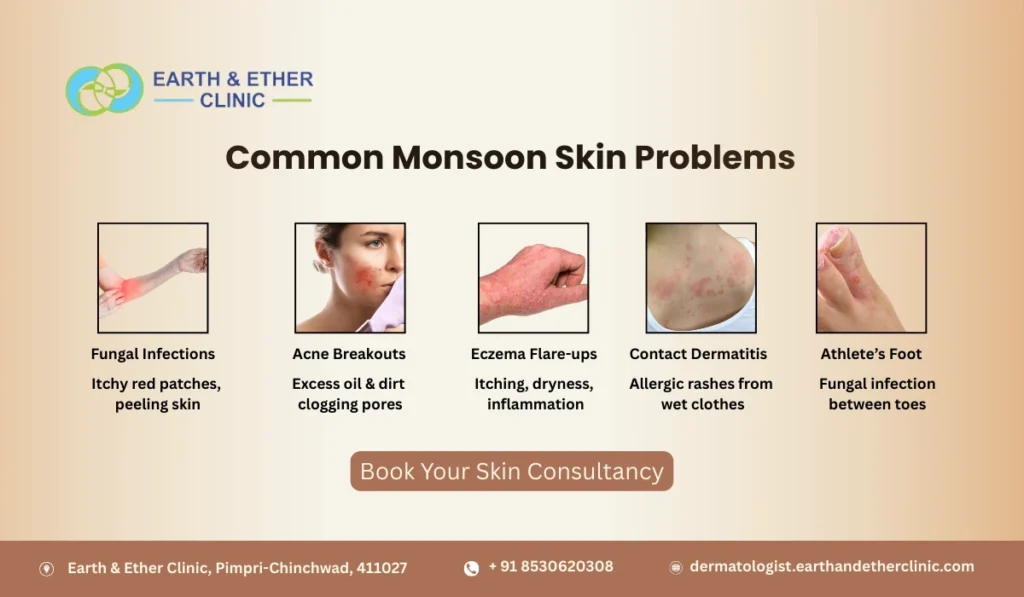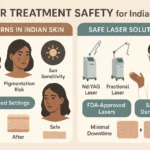Monsoons provide relief from the heat of Pune sizzler, but mark the onset of skin troubles for a number of people. High humidity accompanied by muggy conditions, and the heat brings a certain level of warmth, creating the perfect conditions for bacteria and fungi to thrive. This results in skin problems from mild dermatitis to deep seated infections.
As a skin consultant in Hinjewadi and a practicing dermatologist in Akurdi, Dr. Varsha Rangari of Earth & Ether Skin Clinic says that there has been a notable increase in the number of patients dealing with acne, and eczema exacerbations, and fungal infections during the rainy season. The positive thing is that it is possible to enjoy the monsoons with the right guidance and precautionary measures, so there is no need to stress about skin care.
As such, this article will elaborate on the common skin troubles faced during monsoon in Pune, the most well-known causes, prevention methods advised by dermatologists, and modern methods of skin care.
What Is The Cause Behind The Skin Problems And The Surge In Dermatitis Cases
The monsoon season marks a high range of humidity and excess sweating, combined with the exposure to rainwater creates the indoor environment for skin troubles. Modifications in weather during monsoon results in skin imbalance since moisture content is too high along with the moisture from rain, which allows bacteria to fester and grow unhindered.
The monsoon is a time of skin problems for a lot of people, below is a very simple list of the most common problems that are experienced on monsoons:
Dampness and Mold exposure – Prolonged wet clothes alongside shoes acts as a sponge soaking in excess moisture. Along with fungal infections this sopping wet environment leads to skin irritations such as rashes.
Blocked Pores – When sweat and oil combine, they lead to the development of blackheads, whiteheads, and acne.
Allergic Reactions – Skin rashes can occur from rainfall contaminated with a variety of pollutants.
Weakened Skin Barrier – Sudden fluctuations in temperature can make the skin overly sensitive.
- Fungal Infections – This is the Most Prevalent Skin Issue During the Monsoon Season
Monsoons see a surge in fungal infections like ringworm, candidiasis, and athlete’s foot. These infections flourish in skin folds such as the underarms, belly, between the thighs, and in the toes.
Symptoms:
- Reddish patches that are itchy
- Scaling along with skin peeling
- A burning feeling in the affected areas
Prevention:
- Maintain skin fold areas dry and use antifungal powder to keep them dust-free.
- Maintain a loose-fitting cotton clothing that allows air circulation.
- Do not share personal effects like towels to prevent cross infections.
Treatment:
- Affected patients with a mild infection can utilize topical antifungal creams. However, severe cases will need dermatology evaluations with potential oral medications.
- Acne and Breakouts
Increased humidity together with hot weather amplifies sebum production of oil, therefore clogging skin pores and causing acne. This is worsened for those with oily or combination skin types.
Why Acne Worsens in Monsoon:
- Exceeding sweat combined with oil and dirt.
- Warm and damp weather assists with increased bacteria.
- Poor choice of skincare products.
Dermatologist’s Advice:
- Do not skip skincare, make sure to use a gentle, pH-neutral cleanser for washing skin two times a day.
For acne scars, laser treatment for acne scars is safe and effective in Pune.
- Eczema and Dermatitis Flare-Ups
Chronic inflammatory conditions, like eczema, can worsen with humidity and heat. Sweating, allergens, and certain fabrics can also trigger flare-ups.
Symptoms:
- Red and inflamed skin
- Itching with intensity
- Blisters with clear liquids
Prevention:
- Have non-comedogenic, fragrance-free moisturizers at hand.
- Do not scratch to minimize inflammation.
- Select loosely woven cotton over synthetic ones.
Treatment:
With gentle skin regimens, some may be prescribed topical corticosteroids and antihistamines.
- Sensitivity Relating to Rosacea
The visible blood vessels and chronic skin redness are symptoms of rosacea. Changes in weather, like monsoon winds, tend to worsen it.
Prevention:
- Avoid hot and spicy foods, they are linked to triggering rosacea symptoms.
- Shield the skin from abrupt temperatures.
Persistent redness can be effectively managed with lasers specially designed for rosacea, available in Pune.
- Contact Dermatitis
The rainwater allergy triggered by exposure to dust, chemicals, or synthetic fabrics is defined as contact dermatitis.
Symptoms:
- Red and itchy skin
- Swelling
- Burning sensation
Prevention:
- Avoid extended periods in wet clothing.
- Outdoors, use protective garments.
- Use gentle, hypo-allergenic detergents for washing.
- Athlete’s Foot
Athlete’s foot is a fungal disease associated with damp shoes, socks, and feet.
Prevention:
- Stay dry and change into fresh socks regularly.
- Utilize antifungal powders and sprays for preventative care.
- Refrain from walking barefoot in public wet areas.
- Daily Skin Care Routine for Monsoons
Morning Routine
- Cleanse – Remove sweat and oil build-up with a gentle foaming cleanser.
- Moisturize – Apply an oil-free moisturizer.
- Sun Protection – On cloudy days, still apply a non-greasy, water-resistant sunscreen.
Evening Routine
- Cleansing – Remove makeup first to ensure full makeup removal.
- Twice a week, apply a gentle exfoliant to reduce the build-up of clogged pores.
- Use a night cream or hydrating serum to restore the skin barrier.
Home Remedies for Skin and Monsoon
During the monsoon season, people may try to use home remedies to treat skin issues. While neem, turmeric, and aloe vera may have some antimicrobial benefits, they are not a substitute for medical intervention for fungal or bacterial infections.
Dermatologist Tip: Avoid using home remedies without professional guidance. Test a small area first to ensure there are no allergic reactions.
When to Seek Professional Skin Care Help
There are some skin concerns that cannot be managed at home. Professional assistance should be sought for:
- Severe and unexplained skin itching and redness
- Uncontrolled patchy skin rashes
- Pus-filled, painful and swollen bumps
- Discoloration or thickening of skin
Delaying treatment risks the issues becoming worse, slowing recovery time.
Specialized Treatments for the Skin on Earth & Ether Skin Clinic
Acne Scars Treatment with Laser Therapy – Accurate and safe laser treatment for acne scars.
Rosacea Treatment with Laser Therapy – Skin redness improvement and tone correction treatment.
Peeling Treatments – Skin exfoliation with chemical peeling for rejuvenation and skin tone improvement.
HydraFacial – Comprehensive skin cleansing and nourishing facial for skin health.
Acne Scars Treatment with Laser Therapy – Cost Estimates
The cost for laser treatment of acne scars in Pune may vary based on the treatment’s complexity and the number of necessary sessions but in the scope of this treatment, the majority of patients achieve significant results in 3-6 sessions. It is advisable to attend an initial consultation to receive an accurate estimate.
Final Thoughts
The monsoon season in Pune does not have to result in an endless cycle of skin challenges. With a strategic skincare regimen, proactive and prompt dermatological interventions, one can effectively maintain skin health and radiance.
For all skincare concerns, Dr. Varsha Rangari at Earth & Ether Skin Clinic provides advanced and scientifically proven treatments, offering individual acne treatments, treating skin infections, or providing rosacea laser treatment in Pune with full care based on the patient’s requirements.
CTA
Call Earth & Ether Skin Clinic or head online to secure your appointment for a monsoon skincare consultation with Dr. Varsha Rangari, a leading skin doctor in Hinjewadi (dermatologist in Akurdi). Have healthy, problem-free skin this rainy season.





